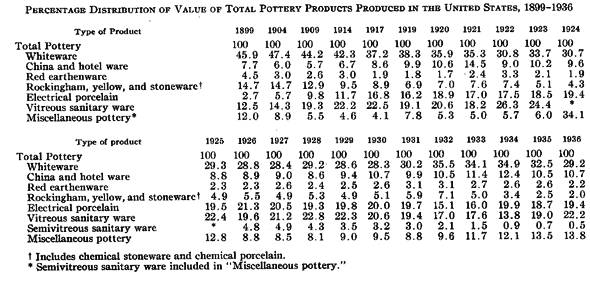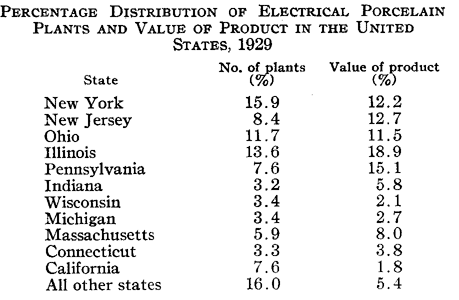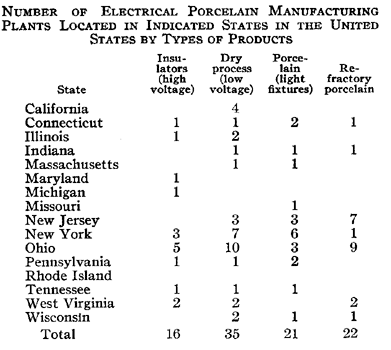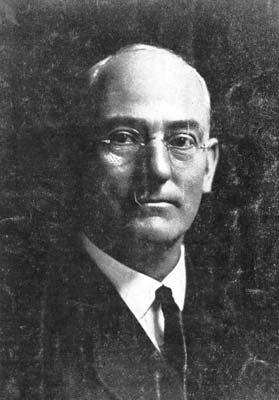[Trade Journal]
Publication: The Bulletin of the American Ceramic Society
Columbus, OH, United States
vol. 18, no. 10, p. 404-408, col. 1-2
CERAMIC HISTORY
EARLY HISTORY OF THE ELECTRICAL PORCELAIN INDUSTRY IN THE
UNITED STATES
By Arthur S. Watts
My earliest personal acquaintance with the porcelain insulator industry came about in July, 1901, when I accepted a position with Fred M. Locke, insulator manufacturer at Victor, N. Y. During the period of my connection with Mr. Locke and the Locke Insulator Company, which extended to 1909, and through my later associations with several other porcelain insulator manufacturers, I have repeatedly observed a wide difference of opinion as to priority in processes and products in this industry.
I started to compile historical material relating to this industry nearly thirty years ago. My memoranda, dated about 1908, lacked supporting data, and its review inspired me to undertake such confirmation as is available. The following information and the sources are the results of my search.
Union Porcelain Works
James L. Jenson, last president of the Union Porcelain Works, Brooklyn, N. Y.
"I cannot furnish the names of founders or the actual date of founding the Union Porcelain Works, but the works were operating before the Civil War in the manufacture of heavy hotel tableware and hardware trimmings. My grandfather, James L. Jenson, was superintendent for many years prior to 1870 when he purchased the Empire China Works at Greenpoint, Brooklyn, N. Y. I have been told many times that the Empire China Works, located at 156 Greene St., Brooklyn, N. Y., produced the first electrical porcelain insulators in the United States by molding in plaster molds for Waldo Bryant of the Bryant Electric Company of Bridgeport, Conn. These were not high-tension insulators, and the Empire China Works and the Union Porcelain Works never manufactured high-tension insulators. They began to manufacture dry-pressed, low-tension insulators only a few years after the Empire China Works, according to my information and recollections."
Author Note: Inasmuch as the first electric light was not installed until 1871, followed by the electric arc light in 1878, and the first commercial motor in 1880, the early production of electrical porcelain insulators by the Empire China Works was related only to experimental projects, and they were not produced on a commercial scale.
Greenwood Pottery Company
David Crossley, President of the Crossley Machine Company, Trenton, N. J., confirms an article by C. C. Treischel (Jour. Amer. Ceram. Soc., 6 [1] 312-14 (1923)).
"In America, as far as the writer can learn, the first electrical porcelain was made by the dust or dry process, and the credit for this accomplishment goes to the Greenwood Pottery Company of Trenton, N. J. This was in 1879. The articles were two-piece insulators, probably knobs, and were given two firings, one biscuit and one glost. Joseph Crossley of Trenton made the dies used in producing these pieces."
R. Thomas & Sons Company
R. Thomas & Sons Company, East Liverpool, Ohio. (Booklet, "Our 50th Year.")
"In 1873, the firm Richard Thomas & Sons was established in East Liverpool, Ohio, to produce doorknobs and specialties. In 1885, the first porcelain insulators were made, going to the U. S. Electric Lighting Company of Chicago at the time of the organization of the National Electric Light Association. In 1887, the company was marketing porcelain insulators to the Brush Electric Association, Detroit Electric Works, Pittsburgh Electric Company, Central Electric Company, Keystone Light & Power Company, Westinghouse Electric Company, et al. In 1892, the R. Thomas & Sons Company was incorporated. Its line consisted of three outdoor types of insulator and nearly one hundred designs for interior wiring. All of the porcelains used in the lighting arrangement for the World's Fair of Chicago in 1893, installed by Westinghouse, were "Thomas." The third issue of the "Thomas" catalogue appeared in 1894, and nearly three hundred insulators were illustrated. Early in 1896, the first "Boch" glaze-filled insulator was perfected, later to be patented. It was the first multipart, high-voltage porcelain insulator manufactured."
Author Note: These dates have been confirmed by members of the early Thomas organizations.
Imperial Porcelain Works
Francis W. Dinsmore, Vice-President, Imperial Porcelain Works, Trenton, N. J.
"The Imperial Porcelain Works was founded in July, 1891, by Frederick A. Duggan, who had been with the Trenton China Company, where in 1888 the manufacture of electrical porcelain was added to the regular line of hotel china and vitrified dinnerware. Benjamin B. Dinsmore, also of the Trenton China Company, went with Mr. Duggan in 1891, later acquiring an interest in the Imperial Porcelain Works. In the beginning, production was confined to dry-pressed or low-voltage porcelain. In the later part of 1894, Fred M. Locke, of Victor, N. Y., was advertising porcelain insulators for high-voltage transmission and was contacted for permission to quote on his requirements. The quotation was made, the order was received, and with the order came a sample of the insulator that Mr. Locke was having made for him. The sample plainly showed that it had been manufactured by the dry-press process, and rather poorly at that, for it looked like a lot of sawdust that was not much more than held together. Upon inspecting the sample, Mr. Dinsmore told Mr. Duggan that he thought a good insulator for high voltage should be made of plastic porcelain, and specimens which Mr. Locke had tested at Cornell University were highly satisfactory. They were installed in California, replacing an original installation of dry-pressed insulators, which had failed to stand 11,000 service voltage. The General Electric Company, which had also made and installed dry-pressed insulators in Utah, gave the Imperial Porcelain Company an order to replace these with Imperial high-voltage insulators. About 1896 or 1897, the R. Thomas & Sons Company started the manufacture of insulators made of two shells of plastic body with a center portion of dry-pressed body, all fastened together with glaze. These were named "glaze-filled insulators," but they were soon superseded by shells fastened together by cement. About 1897 or 1898, Mr. Locke started to experiment with the manufacture of porcelain." (Information given by Benjamin B. Dinsmore.)
General Electric Company
Frank Cermak, Superintendent, Porcelain Factory, General Electric Company, Schenectady, N. Y.
"August Weber and I have made a thorough investigation of the manufacture of dry-pressed porcelain; we find that the General Electric Company of Seventeenth Street and Avenue A, New York, N. Y., made receptacles and cutouts under the Edison patents. The insulating parts, made of wood, were unsatisfactory owing to their fire hazard. They began an investigation of the possible use of porcelain. John J. Kraus manufactured artistic pottery at East Eighteenth Street, New York, N. Y., and William Cermak, my father, was the foreman. They began experimenting with dry-pressed porcelain in 1887, and they put it into production in 1888. The Bergman Electric Company took the total output. This company was absorbed by the Edison Machine Company, which later became the General Electric Company. Wet-process porcelain used as switchboard work by the General Electric Company was made by the Smith Company of Brooklyn, N. Y., until its production began at Schenectady in 1902."
Pass & Seymour, Incorporated
Pass & Seymour history as furnished by Richard Pass, President of the present corporation.
"The company was founded as a partnership in 1890 by James Pass and Albert P. Seymour. Mr. Pass, a potter, was superintendent of the Onondaga Pottery Company of Syracuse. Mr. Seymour was superintendent of the Syracuse Lighting Company. The firm was created to develop the use of porcelain as an electrical insulator in the lighting industry. The porcelain was essentially the same composition as that developed by Mr. Pass for the Onondaga Pottery Company and it sold as "Syracuse china." Plastic molding was used at the start, but dry press was introduced for certain ware about 1891. High-tension insulators were manufactured by throwing and turning during the early years, and later some smaller high-tension insulators were cast. This company manufactured a large quantity of spark plugs by the plastic process and by turning, which was discontinued in 1914. The company's present business is low-tension porcelain wiring and lighting fixtures made chiefly by dry pressing. Some porcelain lighting units and a limited line of high-tension insulating units are cast. No products are made by plastic process at the present time. Periodic updraft kilns, fired by coal, were used from the outset, and these only recently have been partially replaced by a tunnel kiln. The original plant was adjacent to the Onondaga Pottery Company, Syracuse, but it was moved to Solvay in 1900, and the company, Pass & Seymour, Inc., was incorporated in 1901. Mr. Seymour severed his connection with the firm in 1906."
Electrical [sic] Electric Porcelain & Manufacturing Company
Carl F. Adam, Trenton, N. J.
"The Electrical [sic] Electric Porcelain & Manufacturing Company of that city was incorporated by David Crossley, F. F. and J. L. Waechter, and Mr. Adam on April 18, 1895, under the laws of New Jersey, to manufacture porcelain insulating devices for electrical purposes and any and every kind of porcelain ware for any other use and purpose and to sell such products. In 1895, a contract was entered into with Fred M. Locke to manufacture his patented high-voltage insulators. Mr. Adam reports that he induced Jonathan Coxon, Sr., Richard Bryan, and Joseph Mayer, all practical potters operating plants in Trenton, to invest in the company and to assist in the development of vitrified single-fire porcelain. The body was prepared by the normal blunger-filter press process, and the press cakes were reduced to dust by a cyclone-type pulverizer.
"At first a set of permanent magnets was used to remove any tramp iron from the slip, but these were later replaced by the first direct-current electromagnets used in the industry, which were made in my own shop. The ware was formed by means of single- and double-compression dust presses. The first commercial-size kiln was a L. Lawton downdraft, 12 feet in diameter and a 14-foot crown, with four fire mouths for bituminous coal. The first body consisted of English ball and china clay, Florida kaolin, Connecticut feldspar, and French flint. The kiln firing was controlled by dry-pressed rings of the same body as the ware. The rings were 3 inches in diameter by 1/2 inch thick with a 1 1/4-inch hole in the center. They were placed in top and bottom trial saggers in each quarter, and one was removed every three or four hours. When 12 1/2% shrinkage was indicated, the kiln was soaked one to two hours and cooled. These porcelain rings tended to bloat and were replaced by rings of a more open and refractory body which were satisfactory. This was before the introduction of pyrometric cones or Veritas firing disks."
Author Note: Mr. Adam believes that David Crossley produced the first single-fire porcelain and that the first single-fire electrical porcelain was made by himself.
Akron Smoking Pipe Company
Akron Smoking Pipe Company, Mogadore, Ohio. (F. W. Butler, President, Akron Porcelain Co., Akron, Ohio.)
"The Akron Smoking Pipe Company was organized in 1890 by J. W. Baker, J. C. McMillen, C. H. Palmer, F. W. Butler, Sr., and Charles Baird to manufacture stoneware smoking pipes with reed stems which were given as premiums by the Diamond Match Company. In 1896, the company started to manufacture standard wiring insulators, tubes, knobs, cleats, etc. These were made from a local stoneware clay. The manufacture of smoking pipes was discontinued a few years later and the name was changed to the Mogadore Insulator Company. At this time, the body was changed to a standard electrical porcelain. In 1920, the standard wiring insulator line was discontinued, and since then production has been confined to dry-pressed electric porcelain specialties for individual customers. In 1928, a new plant was built in Akron, and the name again was changed to the Akron Porcelain Co."
G. F. Brunt Porcelain Company
G. F. Brunt Porcelain Company, East Liverpool, Ohio. (W. F. Steele, associated for many years with Mr. Brunt.)
"The original pottery, known as Henry Brunt & Sons, was established at the foot of Market Street, East Liverpool, Ohio about 1895. One of the sons, G. F. Brunt, with Charles Thompson, began making standard porcelain cleats, tubes, knobs, etc., selling under the name Brunt & Thompson. In 1898, the G. F. Brunt Porcelain Company was formed for the manufacture of this ware and operated in East Liverpool. The operation was moved in 1912 to Worthington, near Columbus, where it continued until 1925 when the business was abandoned and the plant was sold."
Locke Insulator Company
|
Fred M. Locke, insulator manufacturer, Victor, N. Y. (Compiled from the records of men associated with Mr. Locke in the early years of his insulator development and supported by information in possession of the author of this article.)
John S. Lapp, President of Lapp Insulator Company, LeRoy, N. Y., was associated with Mr. Locke from 1896 until Mr. Locke retired from the insulator business. Mr. Lapp's father was associated with Mr. Locke from a much earlier date, and the first insulator patent credited to Mr. Locke was No. 402,752 issued May 7, 1889, to F. M. Locke and J. Lapp. John S. Lapp reports that in 1894 Mr. Locke contracted with R. Thomas & Sons Company of East Liverpool, Ohio, to manufacture porcelain insulators protected by his patents. He later contracted with the Imperial Porcelain Company of Trenton, N. J., and with Jonathan Coxon, Electrical Porcelain & Mfg. Company or Trenton, N. J., for the manufacture of his patented insulators. During this period, he was also having his insulators made in glass by the Brookfield Glass Company of Brooklyn, N. Y. In 1898, Mr. Locke started the manufacture of plastic-molded porcelain insulators in Victor, N. Y. Mr. Locke's contributions to the development of high-voltage porcelain insulators are evidenced by many early patents in addition to the original referred to. The U. S. patents for insulators issued to F. M. Locke were as follows: 520,367, May 22, 1894; 26,323, Nov. 24, 1896; 573,092, Dec. 15, 1896; 590,806, Sept. 28, 1897; 605,109, June 7, 1898; 32,741, May 29, 1900; and 34,450, April 30, 1901.
Mr. Locke experimented with numerous porcelain and stoneware bodies and glazes in the early years at Victor, N. Y.
According to Walter A. Weldon of Baltimore, Md., M. Brace, Edward Gouldrich, and Van Bennett of Victor, N. Y., all among the first employees at Victor, Mr. Locke started with a body consisting of feldspar, flint, and English and Tennessee ball clays. The glaze consisted of a fusible local clay which gave a light yellow color. Later he attempted to use a Pennsylvania fire clay with this local slip clay as a flux. This body was in production in 1901, but before 1902 it was replaced by the typical high feldspar, high ball clay, low china clay, and low flint porcelain, typical of electrical porcelain bodies at the present time. The body was prepared by wet grinding in large ball mills, followed by screen, filter press, and pug mill. No systematic aging was practiced in the early years. The large units were made by jiggering, and the smaller units were made by plastic pressing on a revolving plunger press with plaster molds. No dry-pressed ware was made during the history of Fred M. Locke or of The Locke Insulator Company.
The first kiln was a 9-foot round downdraft kiln with separate stack, built in the spring of 1898, and this type of kiln with modifications was employed exclusively until after 1910. Mr. Weldon reports that Mr. Locke had trouble with the firing of his first insulators, and he finally took them in a basket to Trenton, N. J., where Messrs. Dinsmore fired them for him and otherwise aided him in his problems.
J. W. Ryan, Superintendent, Porcelain Department, Westinghouse Electric & Mfg. Company, Emeryville, Calif, was an early Victor employee. His recollection is that Mr. Duggan of Imperial Porcelain Company developed the first porcelain body used at Victor. Mr. Ryan points out that before 1902 Mr. Locke combined a porcelain head and a glass center in many of the large insulators of that period. The yellow glaze from local slip clay was soon replaced by Albany slip clay and most of the early production had the latter glaze. The white glaze was introduced in 1901 to 1902. Mr. Locke organized the Locke Insulator Company in 1902 and retired from the management in 1904. He was succeeded by John S. Lapp, whose records have been used in compiling this history.
Star Porcelain Company
Star Porcelain Company, Trenton, N. J. (R. W. Ferguson, President, Star Porcelain Company.)
"The Star Porcelain Company was organized in the spring of 1899 by Charles P. Britton, Thomas W. Mackenzie, and Herbert Sinclair, the latter possessing the knowledge of the manufacturing processes. They manufactured dry-pressed porcelain until 1901, when a line of high-voltage insulators was added under the supervision of a Mr. Grainger (first name not revealed in the records). Both lines were produced until 1907, when the high-voltage line was dropped, and production has since been limited to dust-pressed products."
Anderson Porcelain Company
Anderson Porcelain Company, East Liverpool, Ohio. (G. O. Anderson, President, Superior Porcelain Company, Parkersburg, W. Va.)
"The factory was built and started production in 1900. The officials were T. F. Anderson, President; T. B. Anderson, Vice-President; and G. O. Anderson, Secretary-Treasurer. In the beginning, only tubes, cleats, and knobs were made, but in 1905 a line of pintype and strain insulators was added. The company was merged with seven other companies in 1911 to form the General Porcelain Company of East Liverpool, Ohio. In 1913, a large plant was built at Parkersburg, W. Va., and all of the other plants were dismantled. In 1927, the General Porcelain Company was merged with four other companies to form Porcelain Products, Inc."
Summary
The history of the electrical porcelain industry has been confused with the dates of origin of the firms that later entered this field. The manufacture of standard low-voltage insulators by plastic molding, furthermore, has been confused with the manufacture of high-voltage insulators.
Historical Data on Electrical Porcelain Insulators
(1) Empire China Works, Brooklyn, N. Y.; prior to 1879; made the first low-voltage insulators formed in plaster molds.
(2) Union Porcelain Works, Brooklyn, N. Y.; soon after Empire China Works; dry-pressed ware.
(3) Greenwood Pottery Company, Trenton, N. J.; dry-pressed two-fire, 1879.
(4) R. Thomas & Sons Company, East Liverpool, Ohio; low-voltage insulators 1885; outdoor insulators prior to 1892.
(5) Trenton China Company, Trenton, N. J.; low-voltage insulators, 1888.
(6) John J. Kraus, New York, N. Y.; low-voltage insulators, 1888.
(7) Pass & Seymour, Syracuse, N. Y.; plastic-molded low-voltage insulators, 1890; dry-pressed low-voltage insulators, 1891; some high-voltage insulators made by throwing and turning about same time.
(8) Imperial Porcelain Works, Trenton, N. J.; low-voltage dry-pressed insulators, 1891; high-voltage insulators made for Fred M. Locke in 1894.
(9) Electric Porcelain & Manufacturing Co., Trenton, N. J.; low-voltage dry-pressed insulators, 1895; high-voltage insulators made for Fred M. Locke, 1895; produced the first one-fire glazed porcelain.
(10) Akron Smoking Pipe Company, Mogadore, Ohio; dry-pressed insulators, 1896.
(11) G. F. Brunt Porcelain Company, East Liverpool, Ohio; dry-pressed insulators, 1897.
(12) Fred M. Locke, Victor, N. Y.; plastic-molded high-voltage insulators, 1897.
(13) Star Porcelain Company, Trenton, N. J.; dry-pressed insulators, 1899; high-voltage insulators, 1901.
(14) Anderson Porcelain Company, East Liverpool, Ohio; low-voltage insulators, 1900.
Department of Ceramic Engineering
Ohio State University
Columbus, Ohio
Note by Editor
The following history and data appear in the valuable and informing book, Marketing Burned Clay Products, by A. Hamilton Chute, Ph. D., published by the Bureau of Business Research, The Ohio State University, Columbus, Ohio, June, 1939; price $3.50.
"Electrical porcelain has been mentioned since about the middle of the Nineteenth Century. The exhibits at the Crystal Palace in New York in 1853 included "telegraph insulators of white flint," which were employed on the telegraphs in the vicinity of Boston. Two potteries in different eastern states contended for the honor of having made the first telegraph cups for Morse during this early experiments (1830-1842). A pottery in Kaolin, S. C., during the War, made porcelain and pottery insulators for use on the Confederate telegraph lines. An electrical porcelain plant was reported in Trenton, N. J., in 1865, and another in 1891. A Chicago pottery from 1883 was making porous cells for electric batteries. Electrical porcelain manufacture started in Ohio in 1884 at East Liverpool, Ohio, and, in 1890, at Syracuse and Brooklyn, N. Y.
 |
"The early manufacture of electrical porcelain probably consisted largely of household-wiring fixtures and insulating parts, such as lamp sockets and rosettes, switch-bases and fuse-blocks, porcelain tubes, knobs, and cleats. Later, it found limited employment in specialty molded parts for electric motors and appliances. High-tension electric insulators for power distribution lines were made by 1903."
 |
 |

